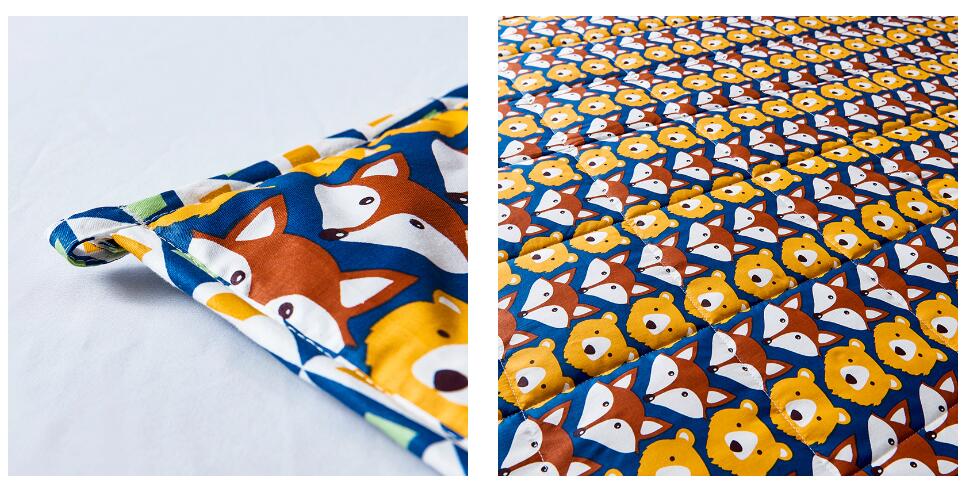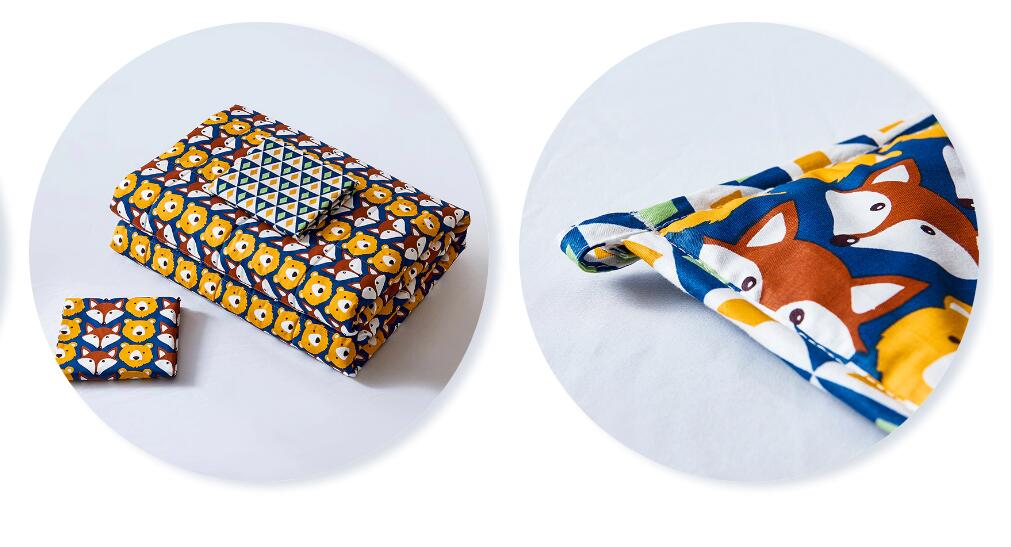A weighted blanket had been first used within the 1970s to assist kids with nervousness, autism, and post-traumatic stress dysfunction (PTSD). Since then, others discovered a extra important profit associated with larger leisure and sleep as a result of the consolation of the weighted blanket kids supplied. The blankets seem to work primarily based on the stress they create that emulates the feeling of a hug. It is that this sense of contact that then supplies the required calming impact that balances feelings, reduces nervousness, and helps put together the physique for sleep.
Weighted blankets benefit
Weighted blankets are having a major moment right now, and their widespread appeal comes as no surprise. For anyone (ahem, most of us) who struggles to settle in for a comfortable eight hours of sleep per night, there's something irresistible about the allure of an everyday blanket that promises to reduce anxiety, stress, and sleepless nights. Plus, if we're being honest, we'll welcome just about any excuse to add yet another blanket, pillow, or a weighted eye mask to our bedtime repertoire for the sake of comfort. Because weighted blankets are designed differently than typical blankets, they require different care. These weighted blankets benefit comprised of several dozen pockets filled with special weighted items. These fillers can include poly-pellets, glass beads, or even rice. Weighted blankets have amazing benefits, improving the overall quality of life for millions of consumers all over the country. Using Deep Touch Pressure, these specially designed blankets, weighing anywhere from 5 to 50 pounds, can help with autism, ADHD, depression, and insomnia. Weighted blankets often come with a hefty price tag and, for most Americans, the price of a weighted blanket is justified as a health investment. An item that is not only expensive but also an invaluable health asset should be washed, cleaned, and treated with appropriate care.
Considerations for using a weighted blanket
Perfectly suits your sleep needs is one thing, but storing and washing weighted blankets is a topic that's slightly more complicated, especially if your blanket isn't safely encased in an easy-to-clean duvet cover. Bulky blankets are anything but easy to fold, and the idea of simply throwing a 20-pound blanket in the washing machine sounds logistically impossible given their heft. So how exactly does one go about keeping their beloved weighted blanket so fresh and so clean? The best way to clean weighted blanket is to first consider its bulk. "Blankets over 20 pounds should be taken to a laundromat and washed in a commercial-size machine simply to spare your home machine from wear and tear. If your blanket clocks in at under 20 pounds, wash it at home on the gentle cycle using cold water and a mild detergent. Blankets with both glass microbeads and plastic poly pellets should be safe in a machine, but it's a good idea to consult the care tag on your blanket just to be sure.
First and foremost, when washing a weighted blanket in a washing machine, make sure to wash it alone in cool water. If a washing machine can typically hold a queen of the king-sized weighted blanket comforter, it can accommodate a weighted blanket that is less than 20 pounds. Generally, if a blanket is more than 25 pounds, it is too heavy to wash in a regular household washing machine.
Second, be sure to use a gentle laundry detergent free of bleach or weighted blanket fabric softener. Steer clear of any detergents advertised as “tough.” Seek out gentle, dye-free detergent or consider making an all-natural detergent at home.
Third, take special care when drying weighted blankets. For best results, either dry the freshly laundered blanket or line dry it naturally. Many weighted blankets are designed to withstand moderate dryer heat without melting. Many weighted blankets have to be dried on low heat and gentle settings to be on the safer side. Also, as a result, they dry evenly.
On the other hand, never apply high heat and always maintain the even distribution of bead fillings. To learn more about how do you wash and dry a weighted blanket, know that when using your normal dryer to dry your calming blanket, ensure that enough space is available for optimal circulation. If not, only avail commercial dryer services from your nearest Laundromat. Air-drying your weighted blanket is considered one of the best ways to go about. That is if you want no damage to your chains, metal beads, and other filling materials. Also, with air-drying, you are assured that your blanket dries uniformly. With air drying, you can also reduce the pilling of some fabrics – such as fleece. However, only lay your blanket flat or hang uniformly.
Generally, weighted blankets that are covered with a duvet or are used on top of a sheet should be washed about four times a year. Of course, if it is used directly on the body, it will need to be washed more frequently. To preserve the quality of the fabric and extend the life of the blanket, utmost care should be taken when laundering weighted blankets. A duvet makes washing and drying much easier: simply remove the duvet cover and toss it in the washing machine, following the weighted blanket manufacturer’s instructions on the tag. Even with a duvet cover, the weighted blanket itself will need to be cleaned periodically. Try airing it out outside on a sunny day where the fresh air and UV rays can naturally clean the blanket. Finally, avoid ironing a weighted blanket. Some consumers who iron sheets or other bedding and prefer to keep things looking neat and wrinkle-free may be tempted to iron a weighted blanket. Resist this temptation!
Even if the fabric itself is iron-safe, the filler probably is not. Most certainly, fillers will be melted and ruined if iron heat is applied to them. Glass beads may not be damaged, but a weighted blanket would be very difficult to maneuver on an ironing board, even if the fabric is iron-safe. For a duvet, ironing may be permissible, depending on its material. Cotton blends can be ironed, but not polyester, Minky, or fleece. As for washing a duvet, it is best to follow whatever instructions are listed by the manufacturer. It still may be a good idea to avoid too much fabric softener or bleach, as it can cause the blanket to wear out faster.

Related products for Weighted Blanket:
Cotton Weighted Blanket Product Features:
◆Spray cotton and glass bead filling, increase product weight, have the feeling of being wrapped.
◆ The small bag can ensure that the beads are fixed in place and evenly distributed. This prevents the beads from slipping and the inside of the quilt.
◆ Three-dimensional quilting technology, fine thread, and fine stitching, quilting qualitative technology.
◆ High color fastness, safe printing, and dyeing, not easy to fade, let you have a healthy life.
Product Parameters of the cotton weighted blanket:
| Product Type | Cotton Weighted Blanket |
| Filling Inside | Glass Beads |
| Color | Yellow or Customized |
| Weight | 5/7/10/12/15/20/25/30lbs or Customized |
| Size | 36×48, 41×60, 48×72, 60×80, 80×87 or Customized |
| 91×122cm, 104×152cm, 122×182cm, 152×203cm, 203×221cm or Customized | |
| Technics | 3.15×3.15, 3.94×3.94,4.72×4.72, 5.91×5.91 Square Stitching |
| 8×8cm, 10×10cm, 12×12cm, 15×15cm Square Stitching | |
| Sample | 1~3 days |
| Package | PE bag, PVC bag, Non-woven bag, Carton, Or Customized |
| Delivery | We cooperate with professional logistics companies to provide efficient goods transports. |
Product picture of the weighted blanket

How do you wash a weighted blanket
We have compiled a list of the most common fabrics used in the making of weighted blankets, along with a set of instructions for how best to care for weighted blankets that are made of those materials.
Wash cotton blankets
As one of the most common fabrics in the world, cotton is simple to care for. Wash cotton weighted blankets separately in cold water. It is always recommended that wash cotton blankets in a load by themselves. Having too many cotton items in the washing machine can agitate the fabric, causing it to wear out faster. Use gentle, chlorine-free detergent with ½ cup of vinegar to preserve the color of the blanket. As always, skip the fabric softener.
Flannel blankets
Flannel is a popular weighted blanket choice of fabric, especially for the sensory-sensitive. Flannel can be washed in cold or warm water, but do not wash with hot water as it will cause flannel to wear out more quickly. Tumble dry in a household washing machine on low heat. Try not to leave it in the dryer so long that it cools. Remove it from the dryer immediately after the cycle has ended because leaving the Flannel blankets in a heated environment for too long will overdry the fibers into the fabric, decreasing their life span. Dryer sheets can be used in the dryer with a flannel weighted blanket. Flannel blankets can also dry naturally quite quickly if the excess water has been removed by a ringer.
Fleece blankets
Fleece blankets can be washed separately in warm water. To remove stains from fleece blankets, try soaking the blanket in the washing machine for 45 minutes before starting the wash cycle. Use a gentle detergent, but fleece can tolerate fabric softener. To reduce fabric softener build-up, which can cause the fabric to become scratchy or rough, give the fleece an extra rinse before starting the spin cycle. Fleece can be dried in the dryer on low heat, but consider air-drying fleece to reduce pilling.
Minky
Some of the best-selling weighted blankets are made with Minky fabric. This is a great fabric for weighted blankets, as it is durable, washes well, and easily maintains its soft texture. Wash Minky fabrics with a non-chlorine bleach diluted in the water. Sometimes, there may be a spot stain on a large blanket that is difficult to wash. If this is the case, try scrubbing the stain from the Minky fabric, with a toothbrush and a drop of gentle detergent. Avoid hot water and high heat settings of the dryer because Minky is a polyester blend that cannot tolerate heat.
Rayon-Linen Blends
Rayon-Linen fabric is a durable, medium weight material that is commonly selected in the making of weighted blankets. Rayon-linen is made from wood that has been pulp-treated with chemicals and is considered a semisynthetic fabric. Sometimes its color can bleed or the fabric can shrink when laundered, so it is usually a dry-clean-only fabric. However, some Minky fabrics can be put in the washing machine or dryer. Be sure to check the label for the manufacturer’s instructions. Wash separately in cold water and air dries only.
Conclusion
Weighted blankets are uniquely designed and have unique washing requirements. Remember, 25 pounds is the cut-off for blankets in a household washing machine. When in doubt as to whether a blanket is too large for a home washing, head to the laundromat. The last thing a consumer wants is a big rip in an expensive weighted blanket! Also, remember that duvets are a great way to protect a weighted blanket, as well as a much easier item to wash. When unsure of how to wash a duvet cover, refer to the manufacturer’s recommendations. Use this guide to effectively clean and maintain a weighted blanket, always taking into consideration its fabric and filler to keep the blanket it the best shape possible.

